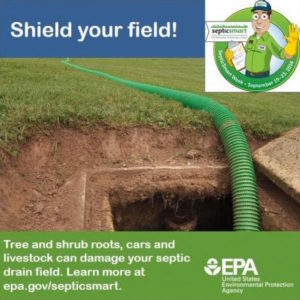Caring for your home septic system doesn’t have to be complicated, in fact, if you follow a few simple maintenance tips, you could save yourself a bundle of cash in repair bills. The key to proper septic tank upkeep comes down to four (4) elements; inspecting and pumping the system frequently, the efficient use of water, proper disposal of waste, and maintaining the drain-field.
Here we have a comprehensive breakdown of these elements so you can take a more proactive approach to septic tank maintenance:
1. Inspecting and Pumping the Home Septic System
It might come as a surprise that most household septic systems need an inspection at least once every three years by a local septic professional. The average septic tank for a Clermont home is pumped once every three to five years. Talking with your local septic company about a service contract could save you a bundle of money every year.
The frequency in which the septic tank should be inspected and pumped depends on the total amount of waste generated, the size of the household, the size of the septic tank, and the volume of the solids that make up the wastewater. If you are going to be calling a local septic tank pumping company to come to the house or you are due for an inspection, here are a few things you should know:
• The septic company will inspect the unit for any leaks and then examine the sludge and scum layers inside the tank.
• Be sure to update your maintenance records each time the professional works on the system. Record scum and sludge levels at this inspection and keep the information so you can provide to the technician at the next service appointment.
• The septic tank utilizes a T-shaped outlet for the prevention of scum or sludge escaping the tank. If the layer is within six (6) inches of the bottom of that outlet, the tank is going to need a pump-out.
 2. The Efficient Use of Water in the Home
2. The Efficient Use of Water in the Home
In the average household, water consumption reaches 70 gallons of water per person. Add into the mix that a leaking toilet wastes 200 gallons of water in a single day and you can see how all that extra water can make a difference. By taking a more proactive stance on water efficiency, it reduces the amount of water processed by the tank. In turn, this limits the risk of septic problems and lowers your water bill at the same time.
Here are a few simple ways that you can control the amount of water that passes through those pipes each day:
• Invest in an Energy Star washing machine. When you have a large family and do several loads of laundry a week, the amount of water wasted in long washing and rinsing cycles can be enormous.
• Low flow toilets remove waste just as efficiently as regular toilets but make use of a fraction of the amount of water to do so. The reservoirs have gone from five gallons all the way to 1.6 gallons; that is a huge amount of water saved on a single flush let alone a year’s worth.
• High-efficiency shower heads reduce the water usage but still provide the same amount of water pressure by making water travel through smaller holes. While you may not notice the difference, your septic tank will be under less pressure during the year to perform.
 3. Follow The “Do Not Flush Rules” To Properly Dispose Of Waste
3. Follow The “Do Not Flush Rules” To Properly Dispose Of Waste
Whether you flush something down the toilet, pour it into the sink, grind it up in that garbage disposal, or clean it in the bathtub, everything will eventually wind up in the septic tank. Certain things you regularly allow to go down the drains could wreak havoc on the system. Don’t use the pipes in your home as trash cans.
Here Is a List of Things That Should NEVER Be Flushed Down the Toilet:
- Feminine Hygiene Products
- Condoms
- Paper Towels
- Diapers
- Baby Wipes or Any “Flushable” Wipes
- Dental Floss
- Cleaning Chemicals
- Sponges
- Q-Tips
- Cotton Balls
- Liquid or Tablet Medication
- Cigarette Butts
- Band-Aids
- Cat Litter
- Hair Clippings
- Chewing Gum
 Additional Items to Keep Out of the Sink/Garbage Disposal Include:
Additional Items to Keep Out of the Sink/Garbage Disposal Include:
- Cleaning Solutions
- Paint/Paint Thinner
- Pills or Liquid Medication
- Cooking Oils & Grease
- Coffee Grounds
- Egg Shells
Remember there are living organisms in the septic tank treating and digesting the waste, and things you flush or pour down the sink or flush down the toilet could kill the helpful bacteria and harm the overall septic system.
If you have frequent guests, be sure to let them know the rules by placing a humorous septic sign or poem in the bathroom.
 4. Maintaining the Septic Drain Field
4. Maintaining the Septic Drain Field
The drain field is a vital part of the septic tank system that works to remove the contaminants from liquids emerging from the tank. Taking a proactive approach to maintaining this area will lessen the likelihood that you have to call in a septic professional to make costly repairs.
• Identify where on the property your tank and drain field are located, then be sure to avoid driving over that region or problems can occur. Avoid parking any types of vehicles or yard equipment over the drain-field.
• Be sure to plant any new trees a safe distance from the septic system for obvious reasons. There may not be trouble today, but years from now those growing roots in their search for water will pierce and penetrate even the strongest systems and result in severe damage.
• Keep your rainwater drainage system, sump pump, or roof gutter away from the drain field location. The accumulation of excess water will disrupt and stop the efficient wastewater treatment process of the septic tank.
 Now you know all the simple and useful tips for caring for your home septic system. Not only will you save money on septic upkeep, but you will also save money in water usage and help conserve our Lake County natural resources as well.
Now you know all the simple and useful tips for caring for your home septic system. Not only will you save money on septic upkeep, but you will also save money in water usage and help conserve our Lake County natural resources as well.
Images provided by United States EPA to help home owners be septic smart!


